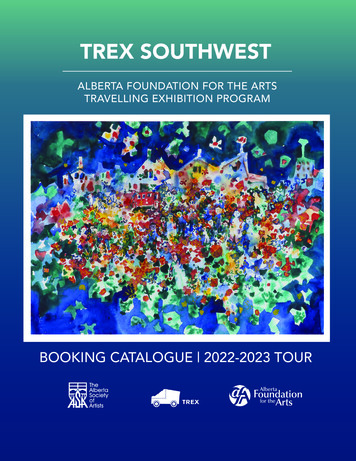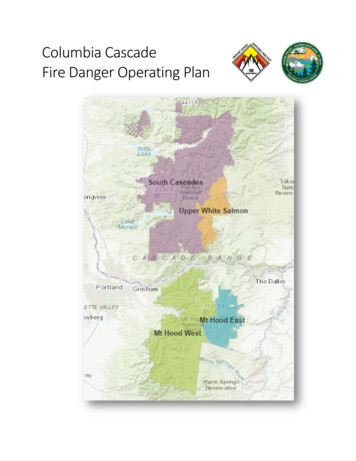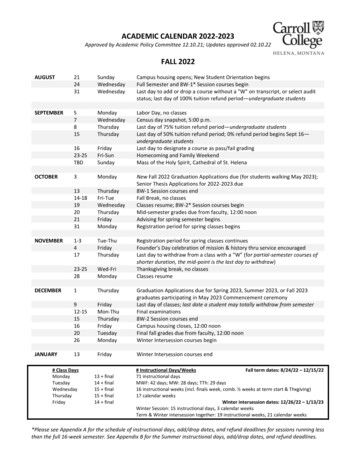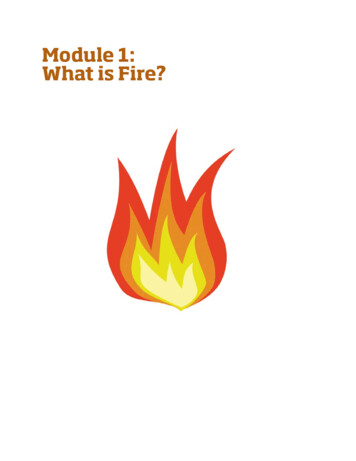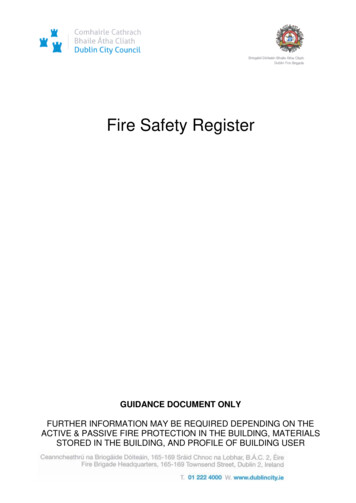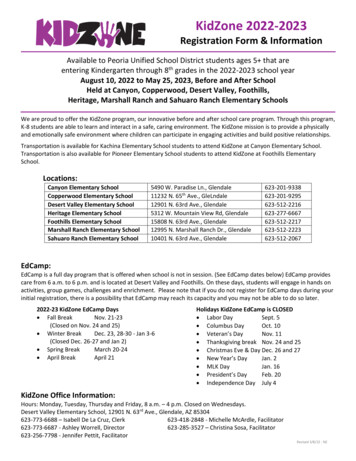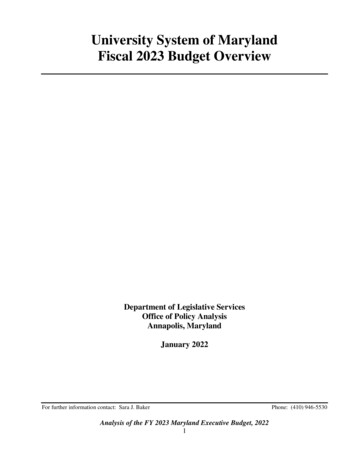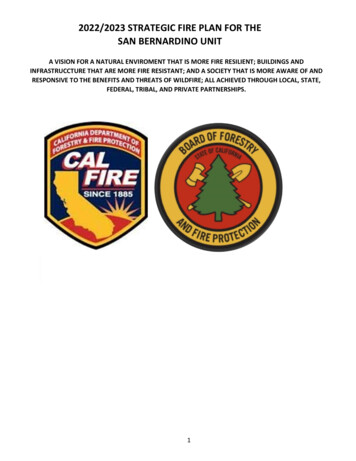
Transcription
2022/2023 STRATEGIC FIRE PLAN FOR THESAN BERNARDINO UNITA VISION FOR A NATURAL ENVIROMENT THAT IS MORE FIRE RESILIENT; BUILDINGS ANDINFRASTRUCCTURE THAT ARE MORE FIRE RESISTANT; AND A SOCIETY THAT IS MORE AWARE OF ANDRESPONSIVE TO THE BENEFITS AND THREATS OF WILDFIRE; ALL ACHIEVED THROUGH LOCAL, STATE,FEDERAL, TRIBAL, AND PRIVATE PARTNERSHIPS.1
UNIT STRATEGIC FIRE PLAN AMENDMENTSDateSection UpdatedPage NumbersUpdatedDescription ofUpdatesUpdatedBy5-1-13Minor changesthroughoutdocumentDebbieChapman5-1-14Minor changesthroughoutdocumentDebbieChapman4-11-15Minor changesthroughoutdocumentDebbieChapman4-21-16Minor changesthroughoutdocumentDebbieChapman1-17-17Minor changesthroughoutdocumentDebbieChapman5-9-18Minor changesthroughoutMattKirkhart5-3-19Several minorchangesMattKirkhart5-6-20Several minorchangesShelleyReddenStephenVolmer5-1-21All sectionsAll pagesMajor edits andupdates to theentire document5-1-22All sectionAll pagesMinor edits and Stephenupdates to entire Volmerdocument2
TABLE OF CONTENTSSIGNATURE PAGEUNIT STRATEGIC FIRE PLAN .4EXECUTIVE SUMMARY.5SECTION I: UNIT OVERVIEW / UNIT DESCRIPTION /UNIT PREPAREDNESS AND FIREFIGHTING CAPABILITIES.6SECTION II: COLLABORATIONCOMMUNITY / AGENCIES / FIRE SAFE COUNCILSPLAN DEVELOPMENT TEAM .8SECTION III: VALUES. 10SECTION IV: PRE-FIRE MANAGEMENT STRATEGIES.13SECTION V: PRE- FIRE MANAGEMENT TACTICS.15BATTALION 1 .15BATTALION 2 .19BATTALION 3 .22BATTALION 4 .27BATTALION 5 .31BATTALION 6.36TRAINING BUREAU .40PREVENTION BUREAU .41RESOURCE MANAGEMENT .44FENNER CANYON CC.49PILOT ROCK FIRE CENTER.52PRADO CC.55OWENS VALLEY CC.60CALIFORNIA INSTITUTION FOR WOMEN (CIW) Training Facility.66IGNITION MANAGEMENT PLAN.68FIRE CAUSES .69EXHIBITS: MAPSDirect Protection Area: San Bernardino County.70Direct Protection Area: Inyo and Mono Counties.71CAL FIRE Wildland Contracts and City Contracts .72Mutual Threat Zone: San Bernardino County.73Solar Mutual Threat Zone .74Highland Wildland Protection Agreement .75APPENDIX A: PRE-FIRE PROJECTS.76APPENDIX B: SAN BERNARDINO UNIT- THREATENED OAKS .78APPENDIX C: ANNUAL ACCOMPLISHMENTS REPORTING .793
SIGNATURE PAGEUnit Strategic Fire Plan developed for San Bernardino Unit:This Plan: Was collaboratively developed. Interested parties, Federal, State, City,and County agencies within the Unit have been consulted and are listedin the plan.Identifies and prioritizes pre-fire and post fire management strategiesand tactics meant to reduce the loss of values at risk within the Unit.Is intended for use as a planning and assessment tool only. It is theresponsibility of those implementing the projects to ensure that allenvironmental compliance and permitting processes are met asnecessary.4
EXECUTIVE SUMMARY:The CAL FIRE San Bernardino Unit is comprised of San Bernardino, Inyo and Monocounties where we carry out CAL FIRE’s mission to serve and safeguard the people,and protect the property and resources of California. This is accomplished through theprotection of State Responsibility Areas (SRA), cities under contract, and by protectionof the public and the watersheds in its geographical area.In response to the unprecedented fire activity, and changing climatic conditions, CALFIRE is reinvigorating its fuel treatment programs, seeking to increase the pace andscale of fuels treatments and prevention activity. The San Bernardino Unit, in support ofthe Department wide effort, has updated the Unit Fire Plan to increase the number ofacres treated, expand the type and variety of prevention activities and to accomplishthat in a strategic manner, which protects the communities and the people who livethere.In addition to the fire threat, the forests and woodlands of San Bernardino County areunder assault from non-native pests, including the Goldspotted Oak Borer (GSOB)which was discovered in the Oak Glen area in 2018. Polyphagous Shot Hole Borer(PHSB) and Kuroshio Shot Hole Borer (KHB) have also invaded the Southwest portion ofthe County killing trees in urban and wildland areas. These pests will dramaticallychange the wildland and urban environments in ways we don’t yet know orunderstand. Unit personnel are working closely with community members, electedofficials and cooperating agencies to mount a united fight against these verydestructive invaders.The Unit Fire Plan that follows, provides a framework for the San Bernardino Unit totake on these and other challenges to help keep the public safe, protect ourcommunities, as well as the natural ecosystems that surround and intertwine them.Respectfully,Unit Chief San Bernardino-Inyo-Mono Unit5
SECTION I: UNIT OVERVIEW UNIT DESCRIPTIONSan Bernardino Unit is spread through four counties spanning the state from centralCalifornia in the eastern Sierras to the counties of Los Angeles and San Bernardinobordering the Pacific Ocean. The total Unit acreage is 1,408,000 of SRA plus 22,756acres of wildland contracts, these are located within San Bernardino, Los Angeles, Inyo,and Mono counties. All the counties have multiple public lands within their responsearea, which include the Bureau of Land Management, National Forest, National ParkService, US Fish and Wildlife, California State Parks, and local county parks.The pre-dominate fuel type is grass and sage, however, there are large areas within SRAthat have timber and 6’-10’ coastal chaparral. The fuel conditions in SanBernardino can change rapidly due to drought or Santa Ana winds which can changefuel conditions from low burning indices to extreme indices within a few of hours.There is no one type of general topography in the Unit, but a general description wouldbe that the Unit has the lowest and the highest elevation in North America. The terrainvaries from flat and rolling hills to the slopes of the Sierra Mountain Range.There have been 118 fires in San Bernardino Unit since 1960 that have exceeded 2000acres, the largest fire being the Old Fire in 2003 that exceeded 91,000 acres, destroyedover 400 homes, with 6 lives lost. There have been numerous large fires with loss of lifeand property in the Unit some of the worst being; the 1980 Panorama Fire 23,625acres, the 1999 Turtle Fire 3,396 acres, the 2006 Sawtooth fire 61,766 acres, the 2008Freeway Fire 30,305 acres, the 2015 Round Fire 7,000 acres and the 2016 Pilot and BlueCut Fires, burning 8,110 and 36,274 acres respectively. Most fires in the unit have theprimary factors of being wind driven and heavy fuel loading to promote extreme ratesof spread. The growing wildland urban interfaces mean that 95% of all fires within theunit have potential to destroy property, life, and high value watershed.UNIT PREPAREDNESS AND FIREFIGHTING CAPABILITIESA.CAL FIRE Facilities and Initial Attack Resources1. Engine Stations Apple Valley: (1)-Type 3 EngineBig Bear Valley: (1)-Type 3 EngineBishop: (1)-Type 3 EngineChino Hills: (1)-Type3 EngineCrestline: (1)-Type 3 EngineDevore: (1)-Type 3 EngineIndependence: (2)-Type 3 EnginesLucerne Valley: (1)-Type3 EnginePhelan: (2)-Type 3 EnginesRunning Springs: (1)-Type 3 EngineSky Forest: (1)- Type 3 EngineYucaipa: (2)-Type 3 EnginesYucca Valley: (2)-Type 3 Engines6
2. Camps and Aircraft Fenner Canyon Conservation Camp, Valyermo, CA (6)-Type 1 Hand crews Owens Valley Conservation Camp, Bishop, CA (5)-Type 1 Hand crews Pilot Rock Fire Center, Crestline CA (5)-Type 1 Fire Fighter I Hand crews Prado Conservation Camp, Chino CA (4)-Type 1 Hand crews Prado Helitack, Chino, CA (1)-Type 2 Helicopter with Crew California Institute for Women (CIW), Chino, CA Female Inmate Training CenterB.Local Fire Departments that have Mutual/Automatic Aid Agreements with CAL FIREBDU:1.Apple Valley Fire Protection District, Apple Valley, CA2.Bureau of Land Management, San Bernardino & Inyo Counties, CA3.Inyo County Volunteers, Inyo County, CA4.Loma Linda Fire Department, Loma Linda, CA5.Los Angeles County Fire, Los Angeles City, CA6.Mono County Volunteers, Mono County CA7.National Park Service, San Bernardino, CA8.Rancho Cucamonga Fire Protection District, Rancho Cucamonga CA9.City of Redlands Fire Department, Redlands CA10.Running Springs Fire Department, Running Springs, CA11.San Bernardino County Fire Department, San Bernardino, CA12.San Bernardino National Forest, San Bernardino, CASan Manuel Fire Department, San Bernardino, CA14. Bureau of Indian Affairs, Bishop, CA15. Chino Valley Independent Fire District, Chino, CA16. CAL FIRE Riverside/Riverside County Fire Department, Perris, CA13.7
Dispatch Agreements:C.1.Arrowbear Lake Fire Department, Arrowbear, CA2.Morongo Valley Community Service District, Morongo, CA3.Newberry Fire Department, Newberry, CAYermo/Calico Volunteer Fire Department, Yermo, CA5. Daggett Community Service District, Daggett, CA4.SECTION II: COLLABORATION COMMUNITY / AGENCIES / FIRE SAFE COUNCILSRepresentatives involved in the development of the Unit Strategic Fire Plan are included inthe following table. Their organization and title are indicated below:Plan Development Team:OrganizationTitleSan Bernardino County FireChiefBig Bear Fire AuthorityChiefSan Bernardino County Public WorksEngineerRunning Springs FireChiefSouthern California EdisonDistrict ManagerConFire CommunicationsGIS AnalystSan Bernardino County SheriffsCaptainCDCR Prado CampOfficerCDCR Fenner CampOfficerCDCR Owens Valley CampOfficerSan Bernardino County OESEmergency Services Officer/CERT AdministratorCAL EMARegion II South – Assistant ChiefCal TransMaintenance SuperintendentSan Bernardino County FirePublic Information OfficerCHPSergeantCrestline-Lake Arrowhead Water AgencyRepresentativeUSFS San Bernardino National ForestDeputy District RangerUSFS San Bernardino National ForestDistrict RangerLos Angeles Dept. of Water and PowerRanch Lands ManagerBureau of Land ManagementDivision ChiefInyo National ForestDivision Chief Bishop AreaInyo National ForestDivision Chief Lone Pine AreaBishop Fire DepartmentChief8
Mammoth Lakes Fire DepartmentChiefInyo County SheriffSheriffMono County SheriffSheriffBureau of Land ManagementDeputy ChiefHumboldt-Toiyabe National ForestFire Management OfficerLone Pine Fire Safe CouncilPresidentTwin Lakes Fire Safe CouncilPresidentSouth Fork Bishop Creek FSCPresidentInland Empire Fire Safe AlliancePresidentWrightwood Fire Safe CouncilPresidentMill Creek Fire Safe CouncilPresidentMountain Rim FSCPresidentArrowhead Communities FSCPresidentRancho Cucamonga FSCPresidentOak Glen Fire Safe CouncilPresidentAngelus Oaks FSCFSC MemberCarbon Canyon FSCChino Valley Fire (FSC Liaison)Bureau of Land ManagementDeputy Chief9
SECTION III:VALUES1.Air Quality:Portions of the Unit reside in the South Coast Air Basin, one of the mostheavily impacted air basins in the nation. The remainder of the Unit liesin the Mojave and Great Basin districts.Ecosystem: Multiple Rare, threatened, and endangered species are found in theUnit. The California Natural Diversity Data Base maintains and updatesthe lists of species monthly.Fire / Flood: Portions of the San Bernardino Unit contain soils, topography, climate,and vegetation that make it one of the most severe fire/flood cyclelocations in the state. The Owens Valley is also subject to severefires/flooding, but to a lesser extent.Fish & Game: Hunting and fishing is one of the biggest draws for recreation in Inyo andMono counties. The Owens Valley and surrounding areas are known forits fishing not only for its native brown trout, but also for its rainbow andbrook trout. For this reason, several State and private hatcheries are inthe area. The San Bernardino Mountains also have several lakes andstreams that provide good fishing opportunities.Historic: Multiple historic and prehistoric sites exist within the Unit. The OwensValley is particularly rich in prehistoric sites. The Information Centers inSan Bernardino and Riverside maintain the archaeological record forareas covered by the Unit. 6. Housing: With increased population growth in Southern California we have seenmore houses being built within the Wildland Urban Interface of SanBernardino County. We have also noticed that more of these residencesare high dollar, large square foot structures, with poor access.Hydroelectric: The Unit has several .1 MW or above hydroelectric facilities in all threeCounties, that lie within the SRA.Infrastructure: Within the Unit we have several major electrical transmission lines thatfeed into the Inland Empire and LA basins. The CAL-NEV pipelinesupplies fuel oil between California and Nevada. The BNSFTranscontinental route between Chicago and Los Angeles is locatedwithin the Unit. The California Aqueduct, Interstate 15, US Highway 395,State Highways 18, 62, and 138 are major transportation corridors. 2.3.4.5.7.8.9.Range: There is minimal rangeland within the Unit. Most is in the Owens ValleyDivision.10
10.Recreation:Recreation is a large part of the Unit. With the San BernardinoMountains and the Owens Valley providing hunting, hiking, biking,fishing, camping, skiing, hang gliding and many other outdoor activities.The desert battalion has numerous Off Highway Vehicle opportunities. Inpeak season the population in some of these areas can double withvisitors.11. Scenic: The Unit boasts several scenic byways. From the Rim of the WorldHighway that runs along the south face of the San BernardinoMountains, and thru the Big Bear Valley, to the majestic views alongHighway 395 that runs through the Owens Valley and up to the Nevadaborder, along with the historic Route 66.12. Soil: In San Bernardino County, we have noticed areas of the mountainsloughing off topsoils. We believe this is caused by the continual intenseburning conditions that have caused most of these areas to type convertthe fuels to annual grasses.13. Timber: Much of the timber in the Unit has little commercial value. The bulk ofits value is in recreation, scenic, and ecological realm.14. Water: The Unit has identified five major watershed areas that are in the VeryHigh Fire Hazard area: Morongo basin, Mojave, Owens, Santa Ana River,and Walker River. There are several other watersheds but most feed intothe ones previously mentioned. Along with the watersheds the Unit hastwo major water transport systems: the California aqueduct and theLADWP water project in the Owens Valley. Both have several lakes andwaterways that make up the system, with most of the water supplying thedemand in the Inland Empire, and LA basins communities.11
SAN BERNARDINO COUNTYINYO COUNTYMONOCOUNTYAdelantoGrand TerracePioneer TownAberdeenAntelope Valley- EastAngeles OaksGreen ValleyLakeRanchoCucamongaAspendellAspen SpringsApple ValleyHesperiaRedlandsBig leBaldwin LakeJoshua TreeRim ForestCartagoCrestviewBig Bear CityLake ArrowheadRunning SpringsIndependenceGreen CreekBig Bear LakeLoma LindaSan Antonio HeightsLone PineJune LakeBig RiverLos SerranoSan BernardinoMustang MesaLee ViningBloomingtonLucerne ValleySugarloafOlanchaMammoth LakesBlue JayLytle CreekSummit ValleySabrinaMono CityBluewaterMentoneTwenty-Nine PalmsStarliteParadise CampCedar Pines ParkMontclairMarine Corps BaseWest BishopPickle MeadowsChinoMorongo ValleyTwin PeaksWhitney PortalSwall MeadowsChino HillsMount BaldyVillageUplandToms PlaceColtonMountain HomeValley ofEnchantmentTopazCrestlineMountain ViewAcresVictorvilleVirginia CreekDevoreMuscoyWest Cajon ValleyDevore HeightsNeedlesWrightwoodFawnskinOak GlenYucaipaFontanaOntarioYucca ValleyForest FallsPhelanGeorge Air ForceBasePinon Hills12
SECTION IV: PRE-FIRE MANAGEMENT STRATEGIESA.FIRE PREVENTION1.2.3.4.5.6.7.8.9.B.Update and implement the Unit Burn Permit Administrative Plan.Continue collaboration with Edison on Operation Santa Ana to reducevegetation fires that are caused when trees, grasses and power linesinteract with one another.Follow up on grant monies for the Fire Prevention roadside signs program.Educate and assist all Chief Officers in the importance of documentationand overall needs to their own battalions pertaining to Fire Prevention.Continue interacting with the Fire Safe Councils within the Unit andreporting back to the Fire Prevention Bureau on the programs establishedwith the councils.Continue with the MAST defensible space demonstration house program.Continue working on the Juvenile Fire Setters (JFS) program, and work onestablishing a JFS program within Inyo and Mono counties.Evaluate and map all fire defense water tanks / cisterns, and truck trails inthe Unit.Utilize Cal Mapper for collecting data, tracking, fiscal reporting, emergencyresponse, planning, and assessment, for fuel reduction projects in the SanBernardino Unit.ENGINEERING & STRUCTURE IGNITABILITY1. Continue to oversee the application of Public Resources Code Section 4290and Title 14 of the California Code of Regulations Section 1270 on all privatelands classified as SRA.2. In addition to the 4290 requirements, local Schedule A contracts haveestablished preplans for commercial occupancies as well as businessinspections of those occupancies.3. Continue to work with the Cities and Agencies within the unit to enforcethe California Code of Regulations (CCR), Title 24, and Part 2, known as the2016 California Building Code (CBC). Along with maintenance and periodicalupdating of the Fire Hazard Severity Zones within State ResponsibilityAreas, any Local Agency Very-High Fire Hazard Severity Zone maps.4. Continue an aggressive LE-100 program to advise property owners of theneed for defensible space around their structures. Clearing vegetation andmaintaining that clearance is required by section 4291 of the PublicResources Code. Additionally, we are working with our cooperators insensitive areas to conduct defensible space inspections and training withintheir jurisdiction on SRA lands.13
INFORMATION AND EDUCATION1. Increase efforts in educating the public regarding debris burning, campfires,and equipment use.2. Increase PSA’s and news releases regarding the laws covering campfiresand debris burning along with proper equipment use in fire prone areas.3. Continue efforts to maintain the message of child fire safety.4. Continue public outreach at San Bernardino County Fair, Tri County Fair,Mule Days, Wrightwood Wildfire and Disaster Awareness fair and other likeevents.5. Continue News Media Fire Safety program.6. Placement and upkeep of roadside Fire Prevention Signs.7. Assist Battalions with Team Teaching Program.8. Recruit and Maintain personnel for the VIP Program. A necessity to assistthe Unit in a variety of Fire Prevention Activities.9. Continue to utilize the San Bernardino Unit web page, Facebook, Instagram,and Twitter.D. VEGETATION MANAGEMENT1. Maintain the cooperative agreement with the Mountain Re-Leafreforestation program.2. Maintain and train personnel on the Units Post Suppression Rehabilitationprogram.3. Continue to conduct Forest Practice inspections pursuant to the ForestPractices Act. The inspections are performed to ensure fuel reduction andlogging operations are conducted per state law in a manner that protects allthe resources in a forest environment.4. Continue to work with the Mountain Area Safety Taskforce (MAST) and FireSafe Councils on the best utilization of fuel projects for community defense,along with the best use of CAL FIRE resources including hand crews andresource personnel for these projects.5. Facilitate development of programs and projects to utilize grant monies forfire prevention projects.C.14
SECTION V: PRE - FIRE MANAGEMENT TACTICSDIVISION / BATTALION / PROGRAM PLANSBATTALION 1:OVERVIEWBattalion 1 consists of three Schedule A fire stations. The Highland, East Highland, andSterling Fire Stations are staffed with a Type I ALS engine at each station. Each Highlandengine is staffed with 3 personnel.The Southern border for Battalion 1 is the Riverside County line, the Eastern border isthe Yucaipa Battalion (Battalion 3), the Northern border is the San Bernardino NationalForest, and the Western border is San Bernardino City (San Bernardino County FireDepartment). The Highland Battalion is comprised of the South-central portion of theCAL FIRE San Bernardino Unit.The local and federal agency fire districts/departments within Battalion 1 are the SanBernardinoNational Forest, the San Manuel Fire Department, the Redlands Fire Department, theLoma Linda Fire Department, the Colton Fire Department, and the San BernardinoCounty Fire Department, A close working relationship is maintained with each district aswell as with the United States Forest Service (USFS).The following is a list of cooperative agreements as well as some local responseagreements:1.2.3.4.Battalion 1 the City of Redlands, City of Colton, City of Loma Linda, and theeastern side of Highland all have a wildland fire protection agreement withCAL FIRE.The City of Highland contracts with CAL FIRE for full-service Fire Protectionand Paramedic Services (Schedule A).There have been numerous wildland fires in the North and South East areaof Battalion 1 that affects many of the surrounding jurisdictions. A greatamount of cooperation and coordination amongst agencies withjurisdictional responsibility has been accomplished to put together a preplan for fire response into the areas served by the many fire departmentsthat protect the area.CAL FIRE-San Bernardino Unit, San Bernardino County Fire, and the SanBernardino National Forest have an XBO response Plan.Agreement for wildland fires in the front country along the base of theSan Bernardino Mountains from San Bernardino City to the east towardsYucaipa City. This plan assists the responding agencies with common15
communications as well as pre- identifying a Unified Ordering Point.Annual training drills keep all involved agencies familiar with the process.Elevations within Battalion 1 vary from 1,869 feet around the Seven Oaks Dam ControlBasin up to 3000 feet above sea level along the front country of the eastern SanBernardino Mountain Range. Fuel types within the Battalion are primarily grassesconsistent with Fuel Model 1 and 2 and shrubs consistent with Fuel Model 5 and 6 inthe SRA.Fire History in the Highland Battalion is very extensive. Notable fires in the last decadeinclude the Florida Fire which burned 450 acres of brush, the Mart Fire which burned900 acres and resulted in evacuations of approximately 200 area homes and atemporary road closure of Highway 330, and the Bridge Fire which burned 450 acresand temporarily closed Greenspot Road for ½ a mile.The protection of the watershed areas in the Highland Battalion is essential inprotecting and enhancing life, property, and infrastructure. On December 22, 2010, amassive mud and debris flood engulfed several neighborhoods in the City of Highland.The protection of the wildland areas is critical to reduce the flooding potential in theHighland Battalion. The urban interface areas spanning across the battalion presents amajor concern and challenge to fire personnel when defending structures from wildlandfire. An active program for conducting inspections by fire personnel helps the home andbusiness owners to be compliant with the requirements set forth in section 4291 of thePublic Resources Code. Several major Freeways run through the Highland Battalion. TheInland Empire, which is the location of the Highland Battalion, has a population ofapproximately two million people. The heavy population increases the potential foraccidental and arson caused fires.Communities at Risk listed by the California Fire Alliance within the Highland Battalioninclude City of San Bernardino, Mentone, City of Redlands, City of Loma Linda, and theCity of Colton.PRIORITIES:A.4291 Public Resources Code Inspections in the SRA and City of Highland MunicipalCode in the LRA:1. Identify high risk areas based on fuel load, road access, and inspectioncompliance history to identify areas of focused inspections for eachBattalion. Conduct inspections Provide educational material to stakeholders and property owners Non-compliance on 3rd inspection results in legal action (citation)This on-going project will hold stakeholders responsible for meeting therequirements of 4291 as defined in the Public Resources Code. It will also increasethe chance of a favorable outcome in the event of wildfire and provide defensiblespace for fire suppression personnel to work, while increasing the margin of safetyfor firefighters and equipment.16
Public Education –Debris Burning:1. Provide education material to permit holders for debris burning.2. All project areas will be pre-inspected prior to issuance of a burn permit.3. Aggressive law enforcement (citation) for burning without a permit.4. Aggressively seek cost recovery when fire has escaped the project arearequiring fire suppression action.C. Public Education – Use of Equipment:Provide Public Education and information. Lack of knowledge of thespecific laws related to open burning and Use of Equipment is often citedby violators as the reason for debris burning violations. Fire Safety andDisaster Preparedness Public Venues for educating the public will beutilized at every opportunity.B.D.E.Fire Prevention Signs:Increase the number of roadside fire prevention education signs. Theroadside fire prevention message reaches many people entering StateResponsibility Lands when strategically placed along majorthoroughfares.Fuels Reduction:There are numerous ongoing fuel reduction projects within the HighlandBattalion that are being accomplished through many Fire Safe Councilsand other entities that have the means to complete this type of work.Fuel reductions have proven very successful in protecting and enhancinglife, property, and infrastructure.Fuel reduction along the identified corridors and Wildland UrbanInterface perimeter can help reduce the number of roadside fires startedby vehicles and discarded burning materials, ensures roads used foraccess and egress do not have fuel loads immediately adjacent to theroadway and provides defensible areas to slow or stop the rate of firespread. Some priority Battalion 1 project areas are identified as follows: Construct and improve fuel reduction programs that border East EndOperational Plan Cooperators DPA. Construct and Improve Fuel Reduction programs that border the SanBernardino National Forest. Improve access roads such as power line roads, truck trails, and hikingtrails.Undertake projects and activities that would reduce roadside startsand provide defensible space along roadways. Ensure a data tracking system is used and shared with all personneldown to the field level.F. High Priority Areas: East Highland’s area State Highway route 330 / 210 corridor17
G.Seven Oaks Dam / Santa Ana River BasinRedlands, Loma Linda, Colton, Wildland Contract areas - surroundingState Responsibility Areas in San Bernardino County and RiversideCounty.State Responsibility Areas Northeast of Highland North of Yucaipa.Public Outreach:1. Organized Venues for Public Education within the Highland Battalion. Station tours at all three Highland Fire Stations.School programs at multiple education levels throughout thebattalion.Annual Citrus Harvest Festival.Annual Open
San Bernardino Unit is spread through four counties spanning the state from central California in the eastern Sierras to the counties of Los Angeles and San Bernardino bordering the Pacific Ocean. The total Unit acreage is 1,408,000 of SRA plus 22,756 acres of wildland contracts, these are located within San Bernardino, Los Angeles, Inyo,

